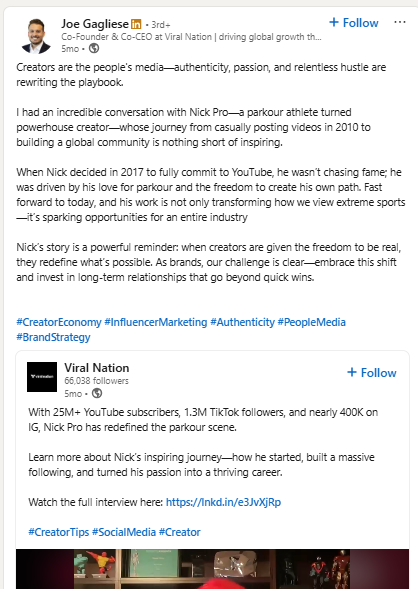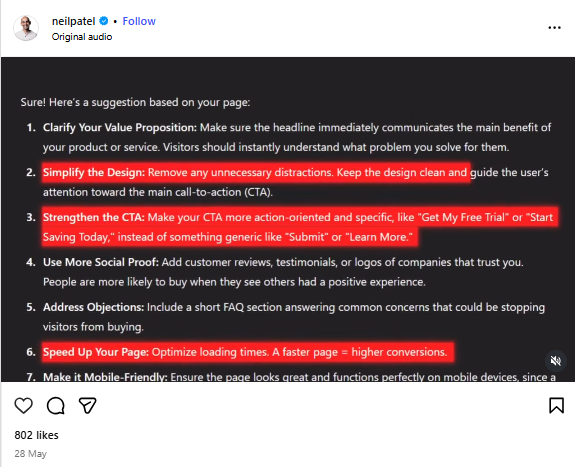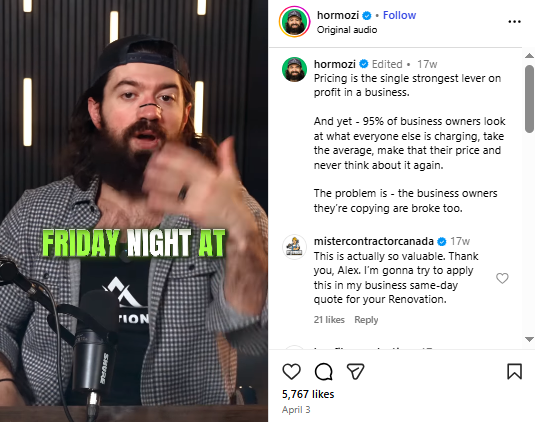
There’s a reason the smartest founders keep showing up on video: it works. Buyers are quicker to trust a face than a logo. A strong founder presence can outpace a dozen email sequences or a polished landing page if the right videos are in place.
Still, most businesses don’t have a plan. They hit record without knowing which videos are effective, and they end up with scattered content that doesn’t support sales or scale with the brand.
Our article discusses five types of videos every founder should have in their content stack. You don't have to limit yourself to these video types. However, these are the standard videos for building a video content system for business.
One brand video on your homepage is no longer enough. Buyers don’t make decisions after watching a single clip. Instead, they move through a series of touchpoints across platforms, emails, and conversations. A generic overview video can’t support that journey.
Today’s B2B buyers expect content that speaks to their exact stage in the funnel. A homepage video might create interest, but it won’t answer deal-specific questions or handle objections. So, it doesn't close a deal.
Similarly, a static brand video also gets stale fast. Teams often spend weeks and five-figure budgets on a polished piece, only to realize they can’t reuse it across channels. It’s not formatted for LinkedIn or is irrelevant for paid ads. That’s a one-off asset with limited shelf life and a small ROI.
Sales and marketing teams need a video content system for business, which is a consistent set of videos that serve clear roles, including awareness, education, trust, and conversion. These might include explainer videos, customer stories, short-form clips for social, or founder-led answers to common objections.
A results-driven video agency won’t pitch a single hero video anymore. They’ll map content to your funnel and audience behavior. At INDIRAP, that's exactly what we do, as this approach allows for testing, repurposing, and better performance across every channel.
When founders speak directly to their audience, they shorten sales cycles and create trust faster than any ad or brochure ever could. However, a modern founder-led video content stack needs to have certain video types for it to work. Here are five of those must-have videos.
Every business has a vision and origin, and who better than the founder to convey it to the customers. Such a video explains why the company exists and why anyone should care. It’s a chance to show the problem you saw, the moment you decided to solve it, and what drives the business now.
Take Emily Weiss, for example. In early Glossier videos, she didn’t rattle off product specs.
She talked about her journey from beauty blogger to founder and her belief that beauty should be led by real people, not retailers. That framing became the foundation of Glossier’s community-led brand.
She also shares her vision for the future on podcasts and in interviews. Her idea of rethinking the business of beauty has become associated with her brand.
Such videos usually sit on the About page or in pitch decks, but they also travel well across sales and investor outreach. It’s often the first content a video marketing agency recommends for positioning a founder as the face of the business.
If you’re building in B2B, think of Eric Siu, who regularly talks on camera about his shift from working in agencies to running one, and why long-term content strategy beats short-term tactics.
His origin story is clear, and it’s helped Single Grain win high-ticket clients who already believe in the approach.
A behind-the-scenes culture video shows how your team works together, day to day. It’s a look inside the rhythm of your business.
Gary Vaynerchuk has done this for years. His DailyVee series showed meetings, brainstorms, and real decision-making with his team. That behind-the-scenes access helped build a level of trust and familiarity that polished marketing content never could.
In B2B, this video type works incredibly well for sales enablement and hiring. It answers two unspoken questions buyers and job candidates often have:
Instead of a script, you need real moments for such videos. A solid video production company like INDIRAP will capture these without making the team feel like they’re being filmed. It's just real people, doing real work, which is what viewers trust.
Customer success commentary isn't exactly like typical testimonial videos. It’s a founder breaking down the story behind a client win, including the challenge, the approach, and the result through your lens. For example, Joe Gagliese, co-founder of Viral Nation, frequently shares client success stories on his LinkedIn.

Instead of handing the mic entirely to the customer, you’re providing context. Why did this deal matter? What can other potential clients learn from it? It's sort of like a hybrid between a case study and a debrief.
Customer success videos work because they build credibility without sounding like an ad. They're especially powerful when paired with stats, screenshots, or B-roll from the project. A strong testimonial video production team can help bring these stories to life.
Every business claims to have a unique process, but only a few take the time to explain it clearly. Product videos solve that.
Here, the founder walks through how the product or service works while tying each feature or deliverable back to a problem the customer cares about.
Most B2B buyers don’t convert because they don’t understand what’s being sold. Even with a good website, friction builds when key details are buried in copy or left to sales reps.
A product video reduces that friction. It helps you control the message and speak directly to the decision-maker’s concerns before the first sales call. Ideally, this video answers common questions you hear from prospects:
When founders address these points directly, they speed up the buying process and set clearer expectations. It also signals transparency, which is a key factor in trust-building, especially in corporate video production for complex services or high-ticket B2B offers.
For format, keep it between 60 and 120 seconds. Use screen recordings, product visuals, or process graphics if needed, but the focus should remain on the founder’s voice.
For example, SaaStr’s Jason Lemkin often posts videos breaking down SaaS business models and outlining sales stages. His videos help founders and sales leaders better understand their own path to revenue.
Short-form social media content allows you to share insights, commentary, or quick stories in under 60 seconds, and they’re optimized for platforms like LinkedIn, Instagram Reels, and YouTube Shorts.
The goal here is to create relevance and familiarity. Prospects who keep seeing your face and hearing your thoughts are far more likely to respond when sales finally reach out. Neil Patel does a great job of this on his Instagram account.

To stay consistent, think in batches. A video production company can film a full day of content and produce dozens of clips, ready to distribute over weeks. These can then be sliced and formatted for each platform’s specs.
For example, Alex Hormozi uses this format daily, breaking down pricing psychology, lead gen, and business operations in under a minute. His clips are straight to the point and consistently rank in high engagement brackets.

Founders often invest in video, but don’t get full value because they stop at posting once on LinkedIn or embedding it on the homepage. A strong content stack also depends on where and how you deploy it. Each video type serves multiple touchpoints across the funnel and across teams.
Here's where to use the aforementioned video types.
Short-form founder clips and product breakdowns are ideal for top-of-funnel awareness campaigns. These videos work well in paid LinkedIn and Meta ads, especially when you’re targeting decision-makers who need quick context before committing time.
Videos that show the founder’s face and voice tend to outperform generic ad creatives in early-stage B2B campaigns. If you’re running a full-funnel strategy, use retargeting ads to deliver testimonial or success story content to warmer leads.
Place your vision or origin videos on the About page or homepage to set the tone. Testimonials and customer commentary videos should live on case study pages or directly on service sections.
Most importantly, videos should not be siloed. It's best to embed them wherever they help remove friction or support buying decisions.
Founders should maintain a consistent cadence of short-form videos on LinkedIn, Instagram Reels, and YouTube Shorts. These help create trust and familiarity over time. Rand Fishkin has done a splendid job of this on LinkedIn.

Behind-the-scenes and commentary-style content performs especially well here. A single shoot can be repurposed into dozens of clips distributed weekly.
The vision video belongs here. Instead of opening with a slide, open with a 90-second video that shows the founder explaining the origin and mission.
It makes your pitch feel human and intentional. For investor-facing decks, pair this with customer success commentary to show proof of traction. The combination lets you move from mission to momentum. Highlight a real use case, how your team delivered, and the outcome.
Some founders also include a short product breakdown video later in the deck. It helps explain technical or service-heavy offerings without relying on dense slides. However, a good practice is to keep it under two minutes and focus on clarity, such as what it does and why it works.
Cold outreach is more effective when you include a video. A personal introduction or product walkthrough from the founder creates differentiation.
These don’t need to be custom-recorded, as generic versions work if they’re relevant and brief. Pro tip: thumbnail previews that link to landing pages with embedded video can increase response rates.
In mid-to-late stage sales, include testimonial or service breakdown videos inside your proposals. It gives buyers a chance to re-watch with their team and helps overcome internal resistance.
Ideally, you want to use all these video types everywhere a conversation happens. If you work with a video production company, they can guide you through this process. At INDIRAP, we have a distribution playbook to help you out.
Creating a full content stack doesn’t mean spending weeks. INDIRAP’s production system makes it possible to film everything you need, including vision, testimonials, product breakdowns, and social clips, in one efficient shoot.
It starts with a strategy call. We align on your goals, audience, and messaging so we’re not guessing what to film, but are building a plan that ties directly to your sales and marketing strategy.
Then, we handle all the pre-production. That includes scripting key talking points, scheduling talent, scouting shoot locations, and prepping any visual assets. You’ll know exactly what to expect before anyone steps in front of the camera.
On shoot day, our crew shows up fully briefed and ready to work. We film founder-led pieces, capture behind-the-scenes footage, and block out time for short-form content in multiple formats. It’s a focused production day, but we make it feel natural and conversational, so you come across like yourself on camera.
Afterward, our editors cut your footage into a high-impact library of videos ready to plug into your website, ads, email flows, and social posts. What you get is a complete, scalable video content system built around your voice in just a single shoot.
Ready to see us in action? Book a free, no-obligation Discovery Call today to build your founder content system in 45 days.
.gif)